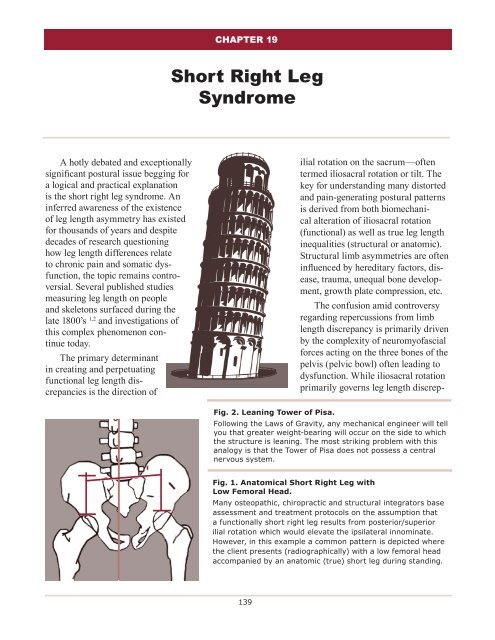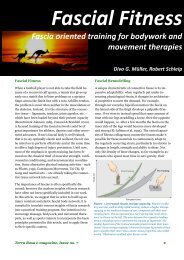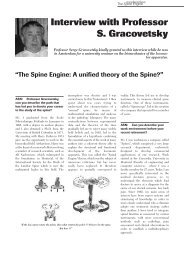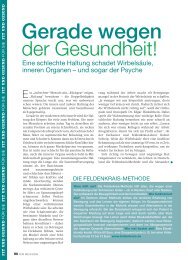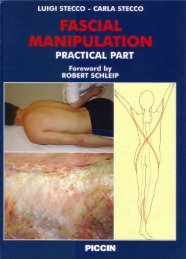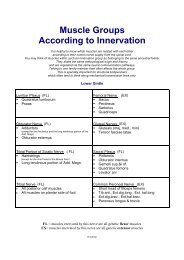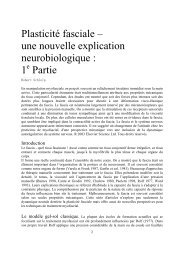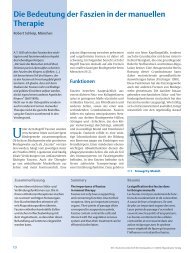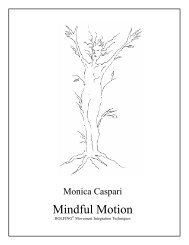Short Right Leg Syndrome
Short Right Leg Syndrome
Short Right Leg Syndrome
Create successful ePaper yourself
Turn your PDF publications into a flip-book with our unique Google optimized e-Paper software.
CHAPTER 19<br />
<strong>Short</strong> <strong>Right</strong> <strong>Leg</strong><br />
<strong>Syndrome</strong><br />
A hotly debated and exceptionally<br />
significant postural issue begging for<br />
a logical and practical explanation<br />
is the short right leg syndrome. An<br />
inferred awareness of the existence<br />
of leg length asymmetry has existed<br />
for thousands of years and despite<br />
decades of research questioning<br />
how leg length differences relate<br />
to chronic pain and somatic dysfunction,<br />
the topic remains controversial.<br />
Several published studies<br />
measuring leg length on people<br />
and skeletons surfaced during the<br />
late 1800’s 1,2 and investigations of<br />
this complex phenomenon continue<br />
today.<br />
The primary determinant<br />
in creating and perpetuating<br />
functional leg length discrepancies<br />
is the direction of<br />
ilial rotation on the sacrum—often<br />
termed iliosacral rotation or tilt. The<br />
key for understanding many distorted<br />
and pain-generating postural patterns<br />
is derived from both biomechanical<br />
alteration of iliosacral rotation<br />
(functional) as well as true leg length<br />
inequalities (structural or anatomic).<br />
Structural limb asymmetries are often<br />
influenced by hereditary factors, disease,<br />
trauma, unequal bone development,<br />
growth plate compression, etc.<br />
The confusion amid controversy<br />
regarding repercussions from limb<br />
length discrepancy is primarily driven<br />
by the complexity of neuromyofascial<br />
forces acting on the three bones of the<br />
pelvis (pelvic bowl) often leading to<br />
dysfunction. While iliosacral rotation<br />
primarily governs leg length discrep-<br />
Fig. 2. Leaning Tower of Pisa.<br />
Following the Laws of Gravity, any mechanical engineer will tell<br />
you that greater weight-bearing will occur on the side to which<br />
the structure is leaning. The most striking problem with this<br />
analogy is that the Tower of Pisa does not possess a central<br />
nervous system.<br />
Fig. 1. Anatomical <strong>Short</strong> <strong>Right</strong> <strong>Leg</strong> with<br />
Low Femoral Head.<br />
Many osteopathic, chiropractic and structural integrators base<br />
assessment and treatment protocols on the assumption that<br />
a functionally short right leg results from posterior/superior<br />
ilial rotation which would elevate the ipsilateral innominate.<br />
However, in this example a common pattern is depicted where<br />
the client presents (radiographically) with a low femoral head<br />
accompanied by an anatomic (true) short leg during standing.<br />
139
140 <strong>Short</strong> <strong>Right</strong> <strong>Leg</strong> <strong>Syndrome</strong><br />
ancy, proper functioning of the sacroiliac joints is<br />
determined by the ten ways the sacrum becomes<br />
asymmetrically fixated between the two innominates.<br />
Both iliosacral and sacroiliac disorders<br />
are intimately affected by various<br />
internal and external forces such as<br />
altered muscle firing order patterns,<br />
motor and vestibular dominance, tonic<br />
neck reflexes, cranial imbalances, viscerosomatic<br />
influences, embryologic<br />
development, and life’s little micro<br />
and macro traumas.<br />
In two exquisitely designed research<br />
studies, Denslow and Chase<br />
measured leg length discrepancy<br />
first in 361 subjects (1962) and<br />
subsequently in 294 subjects (1983). 3<br />
Using the most advanced radiographic<br />
technology available at the time; their<br />
papers reported the following findings<br />
concerning the structural short right<br />
leg syndrome:<br />
• Significant incidence of low right<br />
femoral heads;<br />
• Lumbar convexity to short leg side<br />
(sidebent left/rotated right); and<br />
• A high correlation depicting<br />
contralateral pelvic rotation.<br />
These authors’ findings suggest that<br />
both innominate bones rotate around the<br />
sacrum (iliosacral tilt), and the innominates<br />
and sacrum have the additional propensity to<br />
rotate as a block around the vertical lumbar spine.<br />
Because Denslow and Chase’s research included<br />
pelvic rotation in both the horizontal and sagittal<br />
planes, their work proved instrumental in shaping<br />
the biomedical community’s understanding of the<br />
compensatory mechanisms involved in postural<br />
adaptations to short leg and sacral base unleveling.<br />
Denslow and Chase’s short right leg data not<br />
only confirmed leg length findings conducted by<br />
early researchers but also laid the foundation for<br />
new, more sophisticated studies by investigators<br />
such as John H. Juhl, DO. 4<br />
In Table I, historic references are<br />
presented detailing research papers<br />
comparing femoral head unleveling<br />
and the percentages of short right versus<br />
short left legs. These studies began<br />
with Schwab in 1932 and ended with an<br />
involved and well-constructed project by<br />
Juhl in 2004.<br />
Pain Management and<br />
Pelvic Obliquity<br />
A prerequisite for all pain management and<br />
structural integration therapists requires a basic<br />
understanding of the relationship of iliosacral<br />
unleveling and short leg syndromes. In<br />
the absence of radiographic measurements,<br />
therapist must develop keen palpatory and<br />
Fig. 3. Left Vestibular and <strong>Right</strong><br />
Motor Dominance.<br />
Vestibular dominance controls balance and<br />
tends to travel ipsilaterally up and down<br />
the spine. Therefore, in a clinical setting<br />
we often see clients compressively<br />
load the balance dominant left leg during<br />
standing. Since motor cortex dominance<br />
crosses over to the contralateral side, the<br />
right sided extremities such as arm and<br />
leg will perform most motor dominant<br />
tasks such as throwing and kicking.<br />
visual skills to aid in proper evaluation of bony<br />
and soft tissue landmarks. As Sir William Osler<br />
eloquently stated, “In order to treat something, we<br />
must first be able to recognize it”. Any attempt to<br />
tackle the short right leg syndrome armed with<br />
inadequate assessment and treatment tools will<br />
undoubtedly lead to failure and frustration. This<br />
common pelvic obliquity strain pattern must be<br />
understood and corrected before proceeding to<br />
more complex sacroiliac and lumbar spine dysfunctions<br />
although strain and imbalance in either<br />
of these associated structures can also influence<br />
limb length discrepancy.<br />
Addressing this perplexing structural condi-
<strong>Short</strong> <strong>Right</strong> <strong>Leg</strong> <strong>Syndrome</strong> 141<br />
tion early in the treatment session often sympathetically<br />
corrects lumbosacral and sacroiliac<br />
strain patterns…but not always. Therefore, this<br />
chapter will seek to “weed-through” possible explanations<br />
for the existence of iliosacral rotation<br />
while attempting to uncover the rationale behind<br />
frequently occurring functional and structural<br />
short right legs.<br />
Although this observation can be a causal<br />
factor in pelvic obliquity, other possibilities also<br />
exist. Studies mentioned earlier indicate the presence<br />
of a greater number of true short legs in the<br />
general population than was previously reported.<br />
Figure I radiographically depicts a commonly<br />
seen pattern where a low femoral head is accompanied<br />
by an anatomic (true) short leg during<br />
<strong>Short</strong> Anatomic <strong>Right</strong> <strong>Leg</strong>…<br />
Low Femoral Head?<br />
For years, many osteopaths, chiropractors,<br />
and structural integrators have based therapeutic<br />
protocols on the assumption that a functionally<br />
short leg results from posterior/superior ilial<br />
rotation on the side of the ipsilateral leg (Fig. 1).<br />
This short-leg observation seems obvious since<br />
the ilium should be moving superiorly in order to<br />
“hike” the innominate and pull the leg up with it.<br />
Following this line of thought, a long leg should<br />
result from anterior/inferior ilial rotation on the<br />
ipsilateral side.<br />
TABLE 1 – Comparison with Historic References for<br />
Relative Quantitative Difference on the <strong>Short</strong> or Low<br />
Side of <strong>Leg</strong> Length<br />
Fig. 4. Anteriorly/Inferiorly<br />
Rotated (tilted) <strong>Right</strong> Ilium.<br />
As the right ilium is pulled in<br />
an anterior/inferiorly position<br />
by the iliopsoas and rectus<br />
femoris, the quadratus lumborum<br />
on the left side fights back<br />
by “hip-hiking” the left ilium—<br />
effectively flattening lumbar<br />
lordosis on the left. Lower<br />
quadrant postural muscles,<br />
particularly the iliopsoas and<br />
their synergistic stabilizers…<br />
adductors, TFL, piriformis, etc.<br />
react to right motor dominance<br />
by tightening and shortening.<br />
This causes compensatory rotoscoliotic<br />
lumbar patterns<br />
to reverberate headward.
142 <strong>Short</strong> <strong>Right</strong> <strong>Leg</strong> <strong>Syndrome</strong><br />
standing. Conversely, many clients present with<br />
functionally short right legs combined with anterior/inferior<br />
rotated ilia. An in-depth look at how<br />
this pattern manifests will be discussed later.<br />
Both therapists and researchers have extensively<br />
reviewed the anatomic and functional leg length<br />
theories and noted that gravitational forces should<br />
surely cause one to lean to the short leg side thus<br />
creating greater compression and shortness via<br />
foot hyperpronation, knee buckling, etc. Many<br />
justify this theory with analogies such as this:<br />
“Any mechanical engineer will tell you that when<br />
measuring weight distribution on structures such<br />
as the Leaning Tower of Pisa, the greatest amount<br />
of compressive force will be concentrated on the<br />
side to which this magnificent structure is leaning”<br />
(Fig. 2). The most striking problem with this<br />
analogy is that the Tower of Pisa does not possess<br />
a central nervous system.<br />
R<br />
L<br />
Cerebral Lateralization,<br />
Left Fetal Lie and Posture<br />
Eighty percent of babies presenting in a normal<br />
vertex position assume what is called a left<br />
fetal lie posture and are left vestibular and right<br />
motor dominant. Vestibular dominance controls<br />
balance (equilibrium) and tends to travel ipsilaterally<br />
up and down the spine. Therefore, in a clinical<br />
setting, we often see clients compressively<br />
loading the balance dominant left leg during<br />
stance. This is one of the principal reasons the<br />
left thigh and foot are larger on most people<br />
(remember momma and the shoe clerk making<br />
you try on the left shoe?)<br />
Since motor cortex dominance crosses over<br />
contralaterally, the right-sided extremities (arms<br />
and legs) perform most motor dominant tasks,<br />
such as throwing and kicking (Fig. 3). Many of<br />
the body’s postural muscles, particularly the hip<br />
flexors and their synergistic stabilizers (adductors,<br />
TFL, piriformis, etc.), react to right motor dominance<br />
by tightening and shortening. Tightening<br />
of these postural muscles and their synergistic<br />
stabilizers typically increases lumbar lordosis and<br />
pelvic tilt on the client’s right side as the right innominate<br />
is pulled in an anterior/inferior direction<br />
by the iliopsoas, rectus femoris, etc. (Fig. 4).<br />
To maintain pelvic balance, the brain often<br />
recruits the contralateral quadratus lumborum<br />
(QL) and lateral head of iliocostalis to help counterbalance<br />
the uneven A/P forces traversing the<br />
pelvic bowl. The QL has a propensity for flattening<br />
lumbar lordosis and “hip-hiking” the left<br />
innominate (posterior/superior rotation). Regrettably,<br />
this aberrant anterior/posterior rotational<br />
pattern establishes the uneven base upon which<br />
R<br />
L<br />
Fig. 5. Zink’s Common Compensatory Pattern.<br />
When testing rotation from the cervicocranial to the lumbosacral<br />
regions, Zink discovered that approximately 80<br />
percent of subjects who considered themselves healthy had<br />
fascial rotational preferences of left (cervicocranial), right<br />
(cervicothoracic), left (thoracolumbar), and right (lumbosacral).<br />
These groups with counterbalanced rotational patterns<br />
were more adaptive, healthier and better able to ward off<br />
stress and disease.


